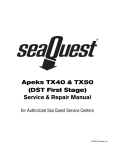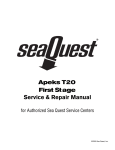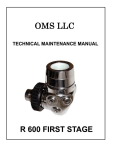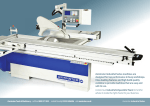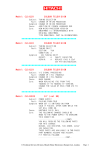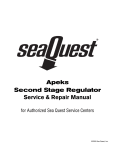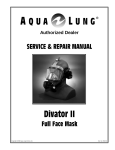Download Sea Quest Apeks Regulator Repair manual
Transcript
Apeks TX100 First Stage Service & Repair Manual for Authorized Sea Quest Service Centers ©2000 Sea Quest, Inc. Contents Introduction .................................................................................................................................................... 3 Safety Precautions .......................................................................................................................................... 3 General Procedures ........................................................................................................................................ 3 Maintenance Schedules ............................................................................................................................ 3 Initial Inspection and Pre-Test ................................................................................................................. 3 Infrequently Used Regulators .................................................................................................................. 4 Work Area & Required Tools ................................................................................................................... 4 O-ring Removal ........................................................................................................................................ 4 Lubrication ............................................................................................................................................... 4 Table 1 – Recommended Tools....................................................................................................................... 5 Table 2 – Lubricant and Cleaner .................................................................................................................. 6 Disassembly Procedures ................................................................................................................................. 7 Disassembly of Yoke Connector .............................................................................................................. 8 Disassembly of DIN Connector ............................................................................................................... 9 Cleaning & Inspection Procedures .............................................................................................................. 10 Reassembly Procedures ................................................................................................................................ 12 Reassembly of Yoke Connector ............................................................................................................. 13 Resassembly of DIN Connector ............................................................................................................. 13 Final Adjustment and Testing Procedures ................................................................................................. 14 Final Assembly ....................................................................................................................................... 15 Table 3 – Troubleshooting ............................................................................................................................ 16 Repair & Replacement Parts ....................................................................................................................... 17 Schematic Drawing ....................................................................................................................................... 18 Apeks Regulator Service and Repair Manual INTRODUCTION Apeks regulators are the product of many years of research and development. Apeks has utilized proven materials and design to maximize reliability and performance. This manual is intended only as a guide for the experienced repair person that has completed a Sea Quest/ Apeks service and repair seminar. It is not intended to educate inexperienced repair personnel or the consumer in all aspects of Apeks regulator repair. Sea Quest/Apeks repair seminars are available periodically to Authorized Sea Quest Dealers. Servicing and repair at the repair shop level mainly involves cleaning, inspection, adjustment, and replacement of worn parts. If you have any questions on any of the procedures, inspections, or tests, please contact Sea Quest at: (877) 253-3483. SAFETY PRECAUTIONS This manual provides step by step instructions for the disassembly, inspection, cleaning, reassembly, and testing of the Apeks TX100 first stage regulator. It is recommended that all steps are followed in the order given. Read each section completely PRIOR to beginning work described in that section. This will familiarize the repair technician with important precautions to take during each service procedure. Pay close attention to all WARNINGS, CAUTIONS, and NOTES that are intended to draw your attention to items of importance. Definition of Warnings, Cautions, and Notes: 3 GENERAL PROCEDURES MAINTENANCE SCHEDULES Regulators are subjected to a variety of environmental elements that over time can affect the performance of the product. As an Authorized Sea Quest/Apeks Dealer you are advised to inform your staff and customer that Sea Quest/Apeks regulator require complete servicing at least once a year. Under certain circumstances a complete servicing is required every 3-6 months. Some of these circumstances are: Frequent or improper use ● Inadequate routine freshwater rinsing ● Regulator use in dirty or polluted waters ● Rental use ● Regular use in chlorinated (pool) water ● Recommended maintenance schedules are based on average use under normal conditions and assume that recommended preventative maintenance and storage procedures have been followed as outlined in the Sea Quest/Apeks owner’s manuals. Advise the customer that any adjustments or servicing on Sea Quest/Apeks regulators must be performed by Sea Quest, or by an Authorized Sea Quest/Apeks Dealer that has attended a Sea Quest authorized service seminar. INITIAL INSPECTION AND PRE-TEST Prior to beginning the servicing of the regulator, a preliminary inspection and pre-test of the entire breathing system is recommended. This will help the repair technician identify any problems that may affect the first stage. Preliminary inspection should include: Indicates a procedure or situation that may result in serious injury or death for either the technician or the user if instructions are not followed correctly. Indicates any situation or technique that may result in potential damage to the product, or render the product unsafe if instructions are not followed correctly. NOTE Is used to emphasize important points and tips. ● First stage inlet filter - If the first stage inlet filter is discolored, the entire regulator should be completely serviced. Deposits of rust (red powder) or aluminum oxide (gray powder) on the filter may indicate that water has entered the SCUBA cylinder and caused internal cylinder corrosion. The customer should be notified that their SCUBA cylinder(s) may be in need of visual inspection, cleaning and testing. Advise your customers to regularly inspect the inlet filter for any discoloration or corrosion. ● High pressure (HP) and low pressure (LP) hoses Inspect the hoses carefully for any evidence of cracking, tearing, or excessive abrasion of the outer rubber covering. Remove all of the hose protectors and examine the area around the metal fittings for any damage to the hose. Inspect the fittings for signs of excessive corrosion. 4 All chrome plated parts - Inspect for any excessive corrosion indicating weak or absent chrome plating. Also look for any signs of peeling or flaking of the chrome plating. ● Regulator pre-test - A regulator pre-test should include all tests outlined in the test section for each regulator. A pre-test will assist the technician in determining if there are any specific performance deficiencies not mentioned by the customer. Apeks Regulator Service and Repair Manual ● Do not use any petroleum based lubricants or products, or any aerosol sprays to lubricate or clean any part or component of Apeks regulators. The petroleum base or propellant gas may attack or weaken the plastic or rubber parts. Refer to Table 2 for approved lubricants. INFREQUENTLY USED REGULATORS Do not assume that the regulator is in good condition because of infrequent use or because it has been in storage. Deterioration of the O-rings and corrosion can still occur under these circumstances. WORK AREA & REQUIRED TOOLS Servicing and repair of the regulator should be carried out in a clean well lighted work area. As each regulator is disassembled all parts should be kept separate from parts of other regulators. Some special tools are required for proper disassembly and reassembly. Please see Table 1 (page 5) for a list of these tools. O-RING REMOVAL When removing O-rings, care must be taken to not damage the regulator surfaces in contact with the O-rings. Tools used to remove O-rings must not have any sharp edges or points that could scratch metal sealing surfaces. Sea Quest strongly recommends that all O-ring removal tools should be made of either brass or plastic. LUBRICATION O-rings should be lubricated with an approved compound (please refer to Table 2 for proper lubricants). O-rings should be lubricated only with a very light film of grease. Do not use spray (aerosol) lubricants under any circumstances. The aerosol propellant may damage the plastic and rubber components of the regulator, and the lubricant will quickly evaporate, providing little or no lasting benefit. Apeks regulators are intended for use in water temperatures warmer than 45ºF (7ºC). Colder water may cause regulators to be more sensitive to a freeflow condition and can lead to a situation that requires an appropriate response to prevent serious injury or death. Users of Sea Quest regulators are advised to ensure that they are adequately trained to deal with a regulator in a freeflow condition or an out-of-air emergency before attempting to dive in a cold water environment. Apeks Regulator Service and Repair Manual 5 TABLE 1 RECOMMENDED TOOLS - TX100 FIRST STAGE Sea Quest Part No. Description Application N/A Padded bench vise Assembly and disassembly of first stage 1003-95 Vise mounting tool Assembly and disassembly of first stage AT30 Pin Spanner Wrench Removal/installation of diaphragm clamp and end cap N/A 1/4" wood or plastic dowel Removal of disc filter N/A 1/2" wood or plastic dowel Installation of disc filter N/A 5mm hex key & hex key socket Removal/installation of blanking plugs N/A 6mm hex key & hex key socket Removal/installation of spring adjuster, HP Plug N/A 3/4" box wrench torque adapter Installation of yoke clamp connector N/A 0-120 inch-lbs torque wrench Small fittings N/A 10-50 foot-lbs torque wrench Large fittings 1116-10 I.P. test gauge Intermediate pressure testing 9440-22 O-ring tools O-ring removal & installation 41532 LP air nozzle Parts drying N/A Magnifier w/ illumination Sealing surface inspection N/A Ultrasonic cleaner - 60HZ, 1.3 amp Brass & stainless steel parts cleaning Apeks Regulator Service and Repair Manual 6 TABLE 2 LUBRICANT AND CLEANER Lubricant / Cleaner Recommended Type Application Source Christo-Lube MCG-111 All O-rings, threaded metal parts as indicated Lubrication Technologies 310 Morton Street Jackson, OH 45640 800-477-8704 Chemical Bath Solution Chromesafe Chrome-plated brass, brass, and stainless steel parts Sea Quest/ Aqua Lung America P/N 0201-05 50/50 mix distilled white vinegar and water Chrome-plated brass, brass, and stainless steel parts Local grocery stores General cleaning solution, degreaser for plastic and rubber parts, leak detection Local grocery stores Liquid dishwashing detergent Joy® (diluted with warm water) DO NOT use muriatic acid for the cleaning of any parts. Muriatic acid, even when strongly diluted, can harm chrome plating, and may leave a residue that is harmful to O-ring seals and other parts. Aerosol spray silicone should be avoided because (1) common aerosol propellants may attack plastic and rubber parts, and (2) because only a slight amount of silicone remains after the solvent evaporates, and provides no lasting benefit. Silicone rubber requires no lubrication or preservative treatment. DO NOT apply silicone grease or spray to silicone rubber parts. Doing so will cause a chemical breakdown and premature deterioration of the material. Apeks Regulator Service and Repair Manual DISASSEMBLY PROCEDURES 1. Before disassembling the first stage, remove the low pressure second stage hoses with a b" open-end wrench, and the low pressure inflator hose with a b" or 2" open-end wrench. Remove the high pressure hose with a s” open-end wrench, or the high pressure port plug with a 5mm hex key. Remove and discard the O-rings from the male fittings of each hose. 2. Install a vise mounting tool (P/N 1003-95) or a discharged C02 cartridge (P/N 7039-09) connected to a HP port adapter (P/N 1020-85) into the HP port of the valve body(7) which is located near the serial number. Figure 1 Removing Environmental End Cap Figure 2 Removing Spring Adjuster Figure 3 Removing Diaphragm Clamp DO NOT use a C02 cartridge that has not been discharged. Doing so may cause the cartridge to rupture, possibly resulting in serious personal injury. 3. Secure the vise mounting tool inside a bench vise so that the first stage is positioned standing vertical outside the vice with the environmental end cap(1) facing up. 4. Mate the pin of the spanner tool (P/N AT30) into the bore hole of the environmental end cap. While holding the spanner tool securely engaged to prevent it from slipping, turn the end cap counter-clockwise to loosen and remove from the diaphragm clamp(6) below it (see Fig. 1). Remove and discard the hydrostatic diaphragm(2). 5. Temporarily loosen the vise to turn the first stage over, in order to remove the hydrostatic transmitter(4). Set the transmitter aside and resecure the first stage in the same position, with the diaphragm clamp facing up. 6. Apply a 6mm hex key to the spring adjuster(5) inside the diaphragm clamp, and turn the spring adjuster counter-clockwise to loosen and remove (see Fig. 2). Lift out the spring(7) and examine it closely with the use of a magnifier to check for any signs of pitting, rusting, or other corrosion that permeates the surface of the metal. Set the spring aside if it is found to be in reusable condition, or replace with new as needed. 7. Mate the pin of the spanner tool into the bore hole of the diaphragm clamp. While holding the spanner tool securely engaged to prevent it from slipping, turn the diaphragm clamp counter-clockwise to loosen and remove from the valve body, along with the spring carrier(8). (See Fig. 3.) 8. Using a 5mm hex key, install spare blanking plugs(19) into three of the four LP ports, leaving the 2" LP port open while the other ports are sealed. 9. Direct a short burst of low pressure (50 psi) air through the primary LP port to partially dislodge the diaphragm(9) from the valve body (see Fig. 4). Lift out the diaphragm and discard. Remove the blanking plugs that were installed in the previous step. 7 Apeks Regulator Service and Repair Manual 8 DO NOT attempt to pry the diaphragm out of the valve body with a metal instrument. Doing so can permanently damage the seating shoulder, requiring replacement of the valve body. 10. Remove the valve lifter(10) from the body and set aside. Loosen the vise to turn the first stage over, and re-secure it so that the flat end (top) faces straight up. 11. Apply a 6mm hex key to the HP balance plug(17), and turn the plug counter-clockwise to loosen until it has completely disengaged from the threads of the valve body (see Fig. 5). Carefully lift out the plug, along with the spring(13) and HP valve(12). 12. Separate the spring and HP valve from the HP balance plug. Discard the HP valve, and closely examine the spring with the use of a magnifier to check for any signs of pitting, rusting, or other corrosion that permeates the surface of the metal. Set the spring aside if it is found to be in reusable condition, or replace with new as needed. 13. Remove and discard both of the static O-rings(15&16) from the HP balance plug, and also the small dynamic O-ring(14) that is held inside the opening. Use only a brass or plastic O-ring tool when removing O-rings from the HP balance plug. Use of a sharp steel instrument can easily scratch the O-ring sealing surface, which will result in a permanent leak that will require replacement of the part. Figure 4 Removing Diaphragm Figure 5 Removing HP Balance Plug 14. Reposition the valve body inside the vice and secure it with the connector (Yoke or DIN) facing straight up. Before proceeding, determine whether the first stage is configNOTE ured with a DIN or yoke connection, and refer to the appropriate disassembly procedure provided below. 15. DISASSEMBLY OF YOKE CONNECTOR A. Remove the yoke clamp screw(27) from the yoke clamp(24) and remove the protective cap(25). Examine the condition of the spare O-ring(26) and replace as needed. B. Apply a w" box wrench to the yoke clamp connector(30). Using firm, steady force, turn the connector counter-clockwise to loosen and remove from the valve body and yoke clamp (see Fig. 6). Lift the connector and clamp straight off the valve body. Separate these items, and set the clamp aside. It is important that the wrench is securely seated over the entire hex surface of the yoke clamp connector to prevent any damage to the part. Do not use impact to loosen. Figure 6 Removing Yoke Connector Apeks Regulator Service and Repair Manual 9 C. Remove and discard the O-ring(29) from the base of the yoke clamp connector. Stand the connector on a flat surface with the disc filter(31) facing down. Insert a 1/4” wooden or plastic dowel, and tap out the filter with a small mallet. 16. DISASSEMBLY OF DIN CONNECTOR Figure 7 Removing DIN Connector A. Remove the protective cap(32) from the threads of the handwheel(35). Apply a 6mm hex key to the hand wheel connector(34), and turn it counter-clockwise to loosen and remove (see Fig. 7). B. Remove both O-rings(33&37) and the conical filter(36) from the handwheel connector. Discard these items and do not reuse. Closely inspect the condition of the handwheel connector, including the thread and the sealing areas of both O-rings. Replace the part if any damage is found, or set it aside to be reused. C. Closely inspect the threads of the handwheel to ensure they are free of any burrs or other damage that could prevent proper threading. Replace the part if damage is found, or set it aside to be reused. 17. Loosen the vice to remove the valve body, and remove the vise mounting tool. Remove all remaining blanking plugs, and remove and discard their O-rings. 18. Under adequate lighting and magnification, closely inspect the condition of the sealing crown inside the valve body to check for any scratches, corrosion, or other signs of damage. If the sealing crown of the valve body appears to be damaged NOTE and a persistent intermediate pressure leak was detected prior to disassembly, it may be necessary to replace the valve body with new. This concludes the disassembly procedures. Apeks Regulator Service and Repair Manual 10 CLEANING & INSPECTION PROCEDURES 1. All parts should be cleaned first in a warm (not over 120°F) mild soap and water solution. Use a soft nylon bristle brush to help remove any excess or loose contamination. After an initial warm water and soap cleaning all parts should be thoroughly rinsed in clean fresh water and dried with filtered low pressure (30 psig) air. After an initial cleaning in warm soap and water solution, metal parts should be cleaned in an ultrasonic cleaner using the appropriate ultrasonic cleaning solution (see Lubricant and Cleaner Table 2). Be sure all O-rings and other rubber or plastic parts are re- NOTE moved before cleaning in an ultrasonic cleaner or chemical bath. Cleaning solutions may damage these components. 2. If an ultrasonic cleaner is not available, metal parts can be cleaned by soaking the metal parts in a chemical bath solution of Chromesafe (see Lubricant and Cleaner Table 2) and agitating gently for 3-4 minutes. Cleaning of metal parts can also be done by soaking in a mild acetic solution (distilled white household vinegar) for 10-15 minutes. Cleaning times in excess of those recommended may damage NOTE plated parts. Never clean parts for longer than specified by the manufacturer of the solution used. After completion of cleaning in any solution, thoroughly rinse parts with clean fresh water and blow dry with low pressure (30 psig) air. Only brass, plated brass, and stainless steel parts should be immersed in chemical cleaning solutions. Use hand and eye protection when handling chemical cleaning solutions. 3. After cleaning, all parts should be thoroughly rinsed in fresh water and dried with filtered low pressure (30 psig) air. Before performing any reassembly, it is important to inspect all NOTE parts, both new and those that are being reused, to ensure that each part is clean and free of any contamination, corrosion, or blemish. 4. All O-rings should be replaced at every servicing. New O-rings should be inspected for contamination and/or imperfections, and lightly dressed with a thin film of approved lubricant prior to installation. (See Lubricant and Cleaner Table 2.) Do not use any petroleum based lubricants or products, or any aerosol silicone sprays on any part of Sea Quest/ Apeks regulators. The petroleum base or propellant gas may attack or weaken plastic or rubber parts. Refer to Table 2 for a list of approved lubricants. Apeks Regulator Service and Repair Manual 11 5. In addition to the O-rings, the following parts should be routinely replaced at the time of servicing: ● Diaphragm (9) ● HP Valve Seat (12) ● Hydrostatic Diaphragm (2) ● Disc Filter - Yoke Clamp Connector (31) ● Conical Filter - DIN Connector (36) All O-rings and the above mentioned routine replacement parts are included in the Overhaul Service Kit (P/N APO227). 6. The following parts should be closely inspected for the damage listed below. Close inspection is best accomplished by using strong magnification under bright lighting. ● Valve Body (11) Inspect all cavities for any nicks, scratches, pitting, or any defects in the plating. Pay particular attention to the sealing edge of the valve cone and the diaphragm seating shoulder. ● Springs (7&13) Inspect for signs of permanent corrosion, including pitting or cracks in the surface of the metal. ● HP Balance Plug (17) Inspect the interior cavity for any nicks, scratches, pitting, or any defects in the plating. ● DIN or Yoke Connector (34 or 20) Examine the condition of the threads and the O-ring sealing groove at the base for any signs of damage. ● DIN Handwheel (35) Examine the condition of the threads for any signs of damage. 7. If any of the listed parts show any damage, they must be replaced with new. 8. Check all metal parts for excessive wear or corrosion. Check all metal sealing surfaces which make contact with O-rings for any signs of contamination and/or imperfections that may cause leakage past the O-ring seal. Examine all chrome plated surfaces for any evidence of peeling or flaking of the chrome plating. Inspect all threads for galling, cross threading, or damage to the chrome plating. If any parts show damage or excessive wear, they must be replaced with new. Apeks Regulator Service and Repair Manual 12 REASSEMBLY PROCEDURES Before performing any reassembly, it is important to inspect NOTE all parts, both new and those that are being reused, to ensure that every part and component is perfectly clean and free of any dust, corrosion, or blemishes. Before dressing each Oring with Christo-Lube®, check to ensure it is clean, supple, and free of any blemish. Use only genuine Apeks parts, subassemblies, and components whenever assembling any Apeks product. DO NOT attempt to substitute an Apeks part with another manufacturer’s, regardless of any similarity in shape, size, or appearance. Doing so may render the product unsafe, and could result in serious injury or death. 1. Insert the stem of the valve lifter(10) into the center bore hole inside the low pressure side of the valve body(11). 2. Lay the diaphragm(9) over the valve lifter inside the valve body, and gently tamp it down below the threads until it is seated evenly on all sides. 3. Place the spring carrier(8) in the center of the diaphragm. Mate the larger diameter threads of the diaphragm clamp(6) onto the valve body, and tighten the diaphragm clamp clockwise by hand until snug. 4. Place the spring(7) inside the center of the diaphragm clamp so that it rests directly over the spring carrier. 5. Mate the spring adjuster(5) into the center of the diaphragm clamp, directly over the spring. Apply a 6mm hex key to turn the spring adjuster clockwise to its correct preliminary setting until it is set exactly 1/4” (6mm) below the rim of the diaphragm clamp (see Fig. 8). 6. Turn the first stage over and carefully lower the sealing end of the HP valve(12) straight down over the pin of the valve lifter, inside the high pressure side of the valve body. 7. Install the small dynamic O-ring(14) into the recess inside the small end of the HP balance plug, and tamp it down with a non-metallic instrument to ensure it is seated evenly on all sides. Next, fit the smaller static O-ring(16) onto the groove near the small end of the balance plug, and the larger O-ring(15) onto the groove at the large end. 8. Fit the spring(13) over the small end of the HP balance plug. Then, carefully mate the balance plug with spring straight down into the valve body, over the stem of the HP valve. Press down with the palm of one hand to compress the spring over the HP valve. While maintaining downward pressure, turn the balance plug clockwise to engage the threads of the valve body, and then continue turning by hand until it is lightly snug. 4" Figure 8 Adjustment Screw Pre-setting Apeks Regulator Service and Repair Manual Figure 9 Installing Yoke Clamp Assembly 13 9. REASSEMBLY OF YOKE CONNECTOR A. Lay a new disc filter(31) inside the yoke clamp connector(30), and press it firmly into place with the use of a wooden or plastic dowel, so that it is seated evenly on all sides. B. Install the O-ring(29) into the bottom of the yoke connector. C. Insert the yoke connector through the bottom of the yoke clamp(24). While holding the yoke clamp and connector together, mate the connector into the valve body and turn it clockwise by hand until snug (see Fig. 9). D. Install a new spare O-ring(26) onto the protective cap(25), and fit the loop end onto the groove at the top of the yoke clamp. Install the yoke clamp screw(27) into the yoke clamp, but do not seal the protective cap at this time. 10. RESASSEMBLY OF DIN CONNECTOR Figure 10 Installing DIN Connector Assembly A. Install both O-rings(37&33) onto the handwheel connector(34). B. Insert the small end of the conical filter(36) through the small Oring and into the threaded end of the handwheel connector, being careful to avoid pressing the filter too far past the O-ring, which will cause it to become unseated. C. Mate the handwheel connector through the threaded end of the handwheel(35). While holding the handwheel and connector together, mate the connector into the valve body and turn it clockwise by hand until snug (see Fig. 10). 11. Install a vise mounting tool (P/N 1003-95) or a discharged C02 cartridge (P/N 7039-09) with a HP port adapter (P/N 1020-85) into the HP port of the valve body(7) which is located near the serial number. DO NOT use a C02 cartridge that has not been discharged. Doing so may cause the cartridge to rupture, possibly resulting in serious injury. 12. Secure the vise mounting tool inside a bench vise so that the first stage is positioned standing vertical outside the vice with the diaphragm clamp facing up. 13. Mate the pin of the spanner tool into the bore hole of the diaphragm clamp. While holding the spanner tool securely engaged to prevent it from slipping, turn the diaphragm clamp clockwise to tighten until it is flush (metal against metal) with the valve body (see Fig. 11). Figure 11 Tightening Diaphragm Clamp Do not install the hydrostatic transmitter, diaphragm, or enviNOTE ronmental end cap until the final adjustment and testing procedures have been completed. 14. Loosen the vise to turn the first stage over, and re-secure it so that the flat end (top) faces straight up. Apply a torque wrench with 6mm hex key socket to tighten the HP balance plug to 12 (±2) foot-lbs. 15. Reposition the first stage inside the vice and secure it with the connector (Yoke or DIN) facing straight up. Apply a torque wrench with a w" box wrench torque adapter (Yoke) or 6mm hex key socket (DIN). (See Fig. 12.) Tighten the connector to 12 (±2) foot-lbs. Apeks Regulator Service and Repair Manual 14 16. Loosen the vice to remove the first stage, and remove the vise mounting tool. Install all O-rings(18, 20, 22) onto all hoses and port plugs(19, 21, 23). Install all LP and HP hoses and port plugs into the valve body, and tighten the port plugs clockwise until snug. Apply a torque wrench with respective crow foot to tighten each hose at the first stage fitting to a torque measurement of 40 (±5) inch-pounds. FINAL ADJUSTMENT AND TESTING PROCEDURES 1. Connect the intermediate pressure test gauge either to a quick-disconnect inflator hose, or to the female fitting of a second stage LP hose, depending on the connection of the test gauge. Check to ensure there are no open ports and that all hoses are securely connected at both ends, with no open fittings. Before testing intermediate pressure, it is important to connect the first stage to a fully assembled and properly adjusted second stage. This will provide a safety relief valve if the intermediate pressure exceeds 155-170 psi. If a properly adjusted second stage is not available, be sure to open the bleed valve of the test gauge before pressurizing. Failure to relieve intermediate pressure in excess of 400 psi may result in damage to the test gauge or LP hose. 2. Check to ensure that the first stage spring adjuster(5) is correctly set to its preliminary adjustment; exactly 4" (6mm) below the top rim of the diaphragm clamp(6). (See Fig. 13.) 3. Connect the first stage to a filtered air source of 500 psi, and slowly pressurize the first stage. While closely monitoring the IP test gauge to ensure that the intermediate pressure does not rise above 120 psi, slowly turn the knob of the bleed valve clockwise until it is shut. If a second stage is not connected to the first stage and the intermediate pressure rises above 200 psi, immediately reopen the bleed valve of the test gauge and shut off the air supply. Refer directly to Table 3 Troubleshooting, and remedy as needed before proceeding further. 4. When the intermediate pressure has stabilized below 120 psi, apply a 6mm hex key to turn the spring adjuster clockwise in small increments of adjustment. While turning the spring adjuster, it is important to simultaneously purge the second stage or briefly turn the test gauge bleed valve open and shut. Monitor the test gauge while adjusting in this manner until the intermediate pressure locks up between 115-120 psi. Failure to cycle the regulator during adjustment can result in a false reading of the intermediate-pressure. Figure 12 Torqueing Yoke Connector 40 (±5) inch-lbs 4" Figure 13 Adjustment Screw Pre-setting Apeks Regulator Service and Repair Manual 15 5. When the intermediate pressure has been determined to be stable at 120 psi or less, increase the inlet pressure to between 2,500 – 3,000 psi while checking the IP test gauge once again to ensure that the intermediate pressure does not rise above 135 psi. If the intermediate pressure rises above 135 psi, immediately purge the second stage, or re-open the bleed valve of the test gauge, and shut off the air supply. Refer directly to Table 3 - Troubleshooting, and remedy as needed. 6. Repeat the adjustment procedure in step 4 to adjust the first stage intermediate pressure to exactly 135 psi. Repeatedly purge the second stage or open and shut the test gauge bleed valve at least 15 times to ensure that the intermediate pressure locks up consistently and remains stable at 135 (±5) psi, with no signs of creeping or fluctuation. Figure 14 Tightening Environmental End Cap 7. FINAL ASSEMBLY a. While the regulator is still pressurized with 2,500 – 3,000 psi, insert the stem of the hydrostatic transmitter(4) into the hex opening of the spring adjuster. b. Lay the hydrostatic diaphragm(2) inside the environmental end cap(1), and tamp it down past the threads to ensure that it seats evenly against the sealing surface. c. Mate the environmental end cap onto the diaphragm clamp and turn it clockwise by hand until snug. Apply the spanner tool to tighten the end cap clockwise until it is completely snug and flush (metal against metal) with the diaphragm clamp (see Fig. 14). d. Cycle the regulator to ensure that the intermediate pressure has not dropped below 135 psi. If necessary, depressurize the regulator and disassemble the environmental kit to reset the intermediate pressure, and repeat steps 6-7. 8. After performing the overhaul and adjustment procedures outlined in the Apeks Second Stage Service & Repair Manual, connect the first and second stage regulators to perform the following tests: 9. External Leak Test – Connect the regulator to a cylinder which contains 2,500 - 3,000 psi, and open the cylinder valve to pressurize the system. Submerge the cylinder and regulator in a test tank of fresh water, and observe closely for up to one minute to check for the formation of bubbles. If a steady stream of bubbles is present, the system must be disassembled to check sealing surfaces, assembly sequence, and component positioning to correct as needed. Before disassembling to correct any leaks, rinse the entire reguNOTE lator thoroughly with fresh water and blow out all residual moisture with filtered, low-pressure (30 psi) air. Disassemble and remedy the problem, referring to Table 3 – Troubleshooting. 10. Subjective Breathing Test – Depress the second stage purge to ensure that the volume of airflow is adequate to clear the second stage. Then, breathe deeply from the mouthpiece. A properly serviced and adjusted regulator should deliver a smooth, uninterrupted airflow upon deep inhalation; without excessive effort, hesitation, or freeflow. If any problems occur, refer to Table 3 – Troubleshooting. This concludes the annual service procedures for The Apeks TX100 First Stage Regulator. Apeks Regulator Service and Repair Manual 16 TABLE 3 – TX100 FIRST STAGE TROUBLESHOOTING SYMPTOM Restricted airflow/ high inhalation resistance through entire system. High or unstable intermediate pressure Low intermediate pressure External air leakage (Immersion Test) -orhydrostatic diaphragm is abnormally distended or burst CAUSE ACTION REQUIRED 1. Cylinder valve not completely opened. 1. Open valve, check fill pressure. 2. Cylinder valve requires service. 2. Connect to a different cylinder. 3. Disc filter(31) is contaminated. 3. Replace with new. 4. Insufficient intermediate pressure. 4. See below. 1. First-stage improperly adjusted. 1. Readjust spring adjuster(5). 2. HP valve seat(12) damaged or worn. 2. Replace HP valve seat. 3. HP balance plug O-ring(14) damaged or worn. 3. Replace O-ring. 4. HP balance plug(17) damaged. 4. Replace with new. 5. Sealing surface of HP valve body(11) damaged. 5. Replace with new. 6. Valve spring(13) weakened or damaged. 6. Replace with new. 1. First-stage improperly adjusted. 1. Readjust spring adjuster(5). 2. Main spring(7) damaged. 2. Replace with new. 3. Diaphragm clamp(6) loose. 3. Tighten flush with valve body. 1. Diaphragm clamp(6) loose. 1. Tighten flush with valve body. 2. Diaphragm(9) worn or damaged. 2. Replace diaphragm. 3. Diaphragm seating surface inside first stage valve body(11) damaged. 3. Replace with new. 4. HP balance plug O-ring(15 or 16) damaged. 4. Replace with new. Entrance of water visible beneath hydrostatic diaphragm 1. Hydrostatic diaphrag(2) worn or damaged. 1. Replace with new 2. Environmental end cap(1) or diaphragm clamp(6) loose or damaged. 2. Inspect both parts and tighten or replace with new as needed. Recommended treatments which require disassembly of the regulator must be performed during a complete overhaul, according to the prescribed procedures for scheduled, annual service. Do not attempt to perform partial service. For assistance with a problem not described here, contact a Sea Quest Technical Advisor. Apeks Regulator Service and Repair Manual 17 REGULATOR REPAIR AND REPLACEMENT PARTS APEKS TX100 FIRST STAGE Item Description Part # Item Description Part # 1 Environmental End Cap AP1484/S 20 O-ring AP1410 2 Hydrostatic Diaphragm AP1482 21 1/2" UNF Blanking Plug AP1487 3 Decal AP1477 22 O-ring AP1409 4 Hydrostatic Transmitter AP1483 23 3/8" UNF Blanking Plug AP1408 5 Spring Adjuster AP1474 24 Yoke Clamp 6 Diaphragm Clamp AP1473 25 Protective Cap AP1404 7 Spring AP1475 26 O-ring AP1166 8 Spring Carrier AP1476 27 Yoke Clamp Screw AP1400 9 Diaphragm AP1478 28 Decal AP5015 10 Valve Lifter AP1479 29 O-ring AP1409 11 Valve Body AP5300/S 30 Yoke Clamp Connector 12 HP Valve Seat AP1419 31 Disc Filter AP1406 13 Spring AP1415 32 Protective Cap, DIN AP1264 14 O-ring AP1299 33 O-ring AP1166 15 O-ring AP1409 34 Handwheel Connector AP1471/S 16 O-ring AP1300 35 Handwheel, 300 BAR AP1470/S 17 HP Balance Plug AP5309 36 Conical Filter AP1472 18 O-ring AP1445 37 O-ring AP1409 19 7/16" UNF Blanking Plug AP1413 38 Decal AP5014 n/s Overhaul Service Kit (Yoke) APO234 n/s Overhaul Service Kit (DIN) NOTE: Items in bold are included in the Overhaul Service Kit AP1403/S AP1407/S APO234/1 18 Apeks Regulator Service and Repair Manual Apeks TX100 First Stage Schematic Drawing


















